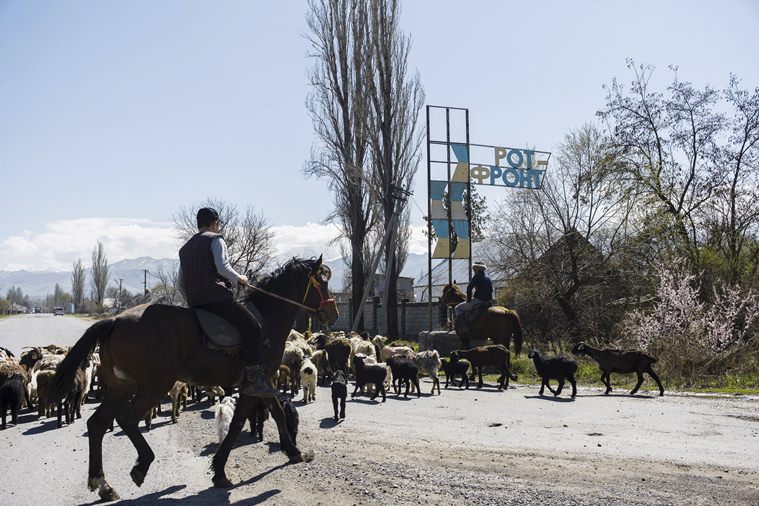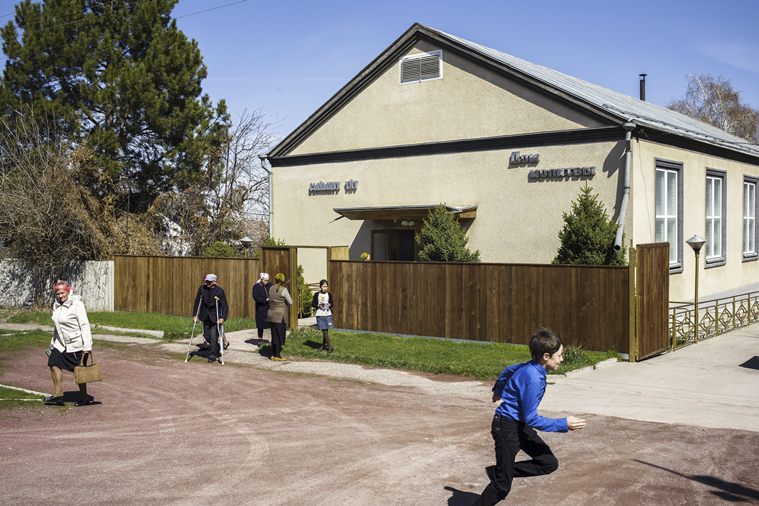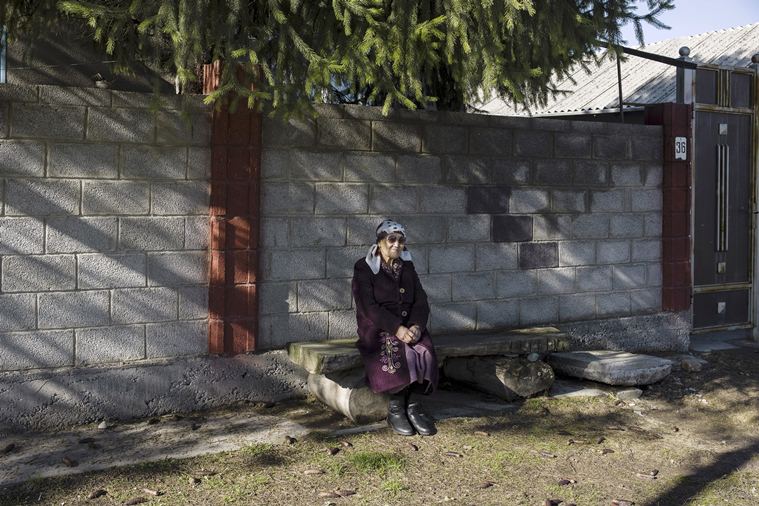
Each Sunday, a rickety white bus wheezes down the main street of one of Christendom’s most remote and odd outposts in the Muslim world.
The bus travels only a few hundred yards but continues a long, meandering journey begun nearly 500 years ago by German-speaking Mennonite Christians fleeing persecution in Europe. Having survived the fury of the Roman Catholic Church, the Russian empire and then the Soviet Union, their community today in Central Asia is small and shrinking but, against the odds, is still hanging on.
Their principal stronghold here is the village of Rot Front, or Red Front, the Soviet-era name of a tidy, two-street settlement at the foot of the Tian Shan Mountains in Kyrgyzstan, a Muslim-majority nation of breathtaking natural beauty and deep poverty formed when the Soviet Union imploded in 1991.
Rot Front, formerly known as Bergtal, or Mountain Valley, is the easternmost outpost of the Mennonite exodus from Europe, which also scattered believers westward to North and South America.
The German community in Rot Front lived for generations in a closed world — entirely German-speaking, dominated by religion, fighting off modern intrusions like television. It is still wary of outsiders but, as residents began emigrating to Germany in the 1990s, and those left behind began using cellphones, interaction with the wider world has grown.

Out of a village with more than 1,000 people, only 10 German families are left. The German bakery closed years ago and the local primary school dropped mandatory lessons in German. The teaching is now all done in Kyrgyz and Russian.
But the Sunday morning bus helps keep alive the religious faith at the heart of the German residents.
Driven by Nikolai Pauls, an ethnic German car mechanic whose 11 siblings have now nearly all left for Germany, the bus collects worshippers — a mix of German Mennonites and Kyrgyz converts — from outside their homes and deposits them at the village’s biggest building, a prayer hall decorated with biblical verses in archaic versions of both German and Russian, written in Gothic script.
Irina Pauls, the bus driver’s wife and a singer in the church choir, said she and her husband had planned to move years ago for Germany but stayed put because their five children did not want to leave their friends.
Whether to leave, she said, “is a very painful question.”
She has often visited relatives in Germany, where nine of her 11 siblings now live, and admires German order and neatness. “Here Kyrgyz people think we are crazy because we cut the grass,” she said.
Three of her grown children have moved to Germany, and she worries about the marriage prospects of the two daughters still in Rot Front. Mennonites rarely marry outside their faith, and while German believers sometimes marry Kyrgyz converts, Pauls said she would like her children to marry fellow ethnic Germans.
“There is still a line between us,” Pauls, 56, said. “The Germans are on this side, the Kyrgyz on the other.”
But finding a suitable spouse for her remaining children, she said, is growing increasingly difficult as emigration drains the pool of eligible grooms and brides who share her family’s faith and speak Plautdietsch, a dialect of Low German.

The Mennonites and Amish both belong to the Anabaptist tradition, a reformation movement dating to the 1500s that rejected aspects of the established Roman Catholic and Protestant churches. They share a commitment to pacifism and simple living.
The German Mennonites who settled in Kyrgyzstan started their journey east in the early 16th century from what is now the northern Netherlands.
After settling first in West Prussia, now part of Poland, they moved on to Russian-controlled Ukraine in the 18th century, and then to Kyrgyzstan, settling first in the west and then on rich farmland in the Chuy Valley east of the capital, Bishkek.
The original German names given their new settlements have mostly been lost. The German names that survive were imposed on towns by Moscow and given a Soviet slant, like Rot Front.
Of the approximately 100,000 ethnic Germans who lived in Kyrgyzstan when the Soviet empire collapsed in 1991, only 8,300 remain.
In Rot Front, the exodus to Germany has been accompanied by a wave of new arrivals, mostly Kyrgyz but also a few Westerners.
A Canadian Christian purchased three houses built by Germans, setting up shelter for Kyrgyz orphans, a guesthouse and a farm.
Wilhelm Lategahn, a non-Mennonite schoolteacher, came to Rot Front from Germany on a government program to promote the German language. He intended to stay a year or so but, nearly a decade later, is still here. He set up a small museum to honor the village’s fading German heritage.
At the prayer hall, built in 1987 after Soviet leader Mikhail Gorbachev relaxed restrictions on religion, female worshippers sit on one side while their husbands, fathers and sons sit on the other.
Germans and Kyrgyz mix constantly — in prayer, at school and at work in the fields, where residents grow their food and raise cattle. They communicate mostly in Russian, the one language everyone speaks fluently.

The village also has a mosque, but it is much smaller than the Mennonite prayer hall.
After attending prayers on a recent Sunday, German and Kyrgyz children gamboled together along the main street, chattering away in Russian. Lotti Schmidt, 12, said she missed friends who had moved to Germany but still wanted her own family to stay in Rot Front.
Even many of those who have left still come back regularly on visits.
Adolf Koop, who moved to Germany in 2011, still keeps the house he and his wife built in 1958 in Rot Front and recently returned with a son and son-in-law to do some repairs.
“I get so bored in Germany,” he said. “I miss all my friends here.”
His memories of Rot Front, however, are not all rosy. His father, the head of the village’s early Soviet-era collective farm, was executed at the height of Stalin’s Great Terror in 1938.
Nazi Germany’s invasion of the Soviet Union in 1941 turned ethnic Germans across the country into enemies of the people. Much of Rot Front’s adult population was sent to labor camps, leaving German children to fend for themselves, often with help from local Kyrgyz, who sheltered and fed them in the mountains.
The wartime experience broke down many of the cultural and language barriers that had previously separated ethnic Germans and the indigenous Kyrgyz population. It also made it difficult for Germans who survived the war in Rot Front to feel comfortable in Germany.
Their offspring, too, can find life in Germany problematic.
Andrej Keller, a 59-year-old ethnic German who was born and raised in Rot Front, said he had tried moving to Germany in 2011, but, unable to find a job, returned to his Kyrgyz village after just 18 months away.
He said he, like many others, had been seduced by the promise of an easy life in Europe.
“Everyone wants to drive a big car, a Mercedes, and eat fat sausages.” he said. “But I was not used to big sausages. Life there was comfortable but I could not get used to it.
“The human needs very little to be satisfied,” he added. “As my mother used to say: ‘To be satisfied you need very little and who is satisfied is a king.’ People never have enough of everything. You have to be happy where you live. If there is no war there, what more do you want?”
“Germany is not our country,” he said. “Our country is here where we were born, this is my home. Here I grew old.”